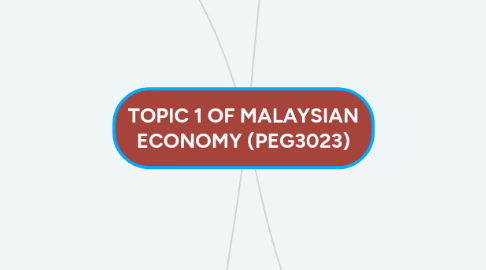
1. ISLAMIC ECONOMIC GROWTH
1.1. DEFINITION: Concepts of halal (permissible) and haram (forbidden) is praticed in the economy
1.2. ECONOMIC GROWTH
1.2.1. Human Resources
1.2.2. Investible Resources
1.2.3. Entrepreneurship
1.2.4. Technological Changes
1.3. OBJECTIVES
1.3.1. Achieve falah
1.3.2. Equal oppurtunities
1.4. ASPECTS
1.4.1. The divine and its creation
1.4.2. The material and spiritual need of human being
1.5. CONCEPTS
1.5.1. Tauhid
1.5.2. Rububiyyah
1.5.3. Khalifah
1.6. DIMENSIONS
1.6.1. Spiritual
1.6.2. Moral & Ethical
1.6.3. Environmental & Physical
1.6.4. Social
1.6.5. Technological Dimensions
1.7. ECONOMIC DEVELOPMENT = ECONOMIC GROWTH + CHANGES
1.8. NEGATIVE IMPACTS
1.8.1. Environmental degradation
1.8.1.1. deforestation
1.8.1.2. loss of biodiversity, ecosystem instabillity
1.8.1.3. pollution - air, water
1.8.1.4. global warming
1.8.2. Moral & Social problems
1.8.2.1. declining moral values
1.8.2.2. social - suicide, baby dumping, theft, gangsterism
1.8.3. Poverty & Unequal Income Distribution
1.8.3.1. higher gap between rich & poor people
2. MALAYSIAN ECONOMY STRUCTURE
2.1. ECONOMIC STRUCTURE
2.1.1. primary
2.1.2. secondary
2.1.3. tertiary
2.2. ECONOMIC STRUCTURE AFTER INDEPENDENCE
2.2.1. Pre-New Economic Policy (Pre-NEP) 1957-1970
2.2.2. New Economic Policy (NEP) 1971-1990
2.2.3. Vision 2020 1990-2020
2.2.4. National Development Policy (NDP) 1991-2000
2.2.5. National Vision Policy (NVP) 2001-2010
2.2.6. New Economic Model (NEM) 2011-2020
2.3. FACTORS CONTRIBUTING TO MALAYSIA'S STRUCTURAL CHANGES
2.3.1. change in economic policy & developmeny
2.3.2. unstable agricultural prices in international market
2.3.3. industrial sector ability to absorb manpower & solve unemployment
2.3.4. availability of resources for industrial sector
2.4. STRUCTURAL CHANGE IMPLICATIONS
2.4.1. increased in GDP & reduced poverty level
2.4.2. reduced dependency on primary sector
2.4.3. migration from rural to urban area
2.4.4. change in country's foreign sector
3. ECONOMIC GROWTH
3.1. DEFINITION: The increase in the amount of final goods and services produced by an economy over time
3.2. FACTORS CONTRIBUTING TO ECONOMIC GROWTH:
3.2.1. 1. abundant natural resources
3.2.2. 2. newly-industrialized and diverse market economy
3.2.3. 3. young, educated & skillful labor force
3.2.4. 4. infrastructure and efficient economic organization
3.2.5. 5. inward investment level
3.2.6. 6. labor mobility
3.2.7. 7. saving levels
3.2.8. 8. corruption levels
3.2.9. 9. political and social stability
4. ECONOMIC DEVELOPMENT
4.1. DEFINITION: Sustained, concerted actions policy makers of a country and societies that promote the standard of living and economic health of a specified area. It is broad and comprehensive
4.2. POSITIVE CHANGES
4.2.1. 1. Socio-economic changes
4.2.1.1. a. human capital development
4.2.1.2. b. infrastructure development
4.2.1.3. c. regional competitiveness
4.2.1.4. d. environmental sustainability
4.2.1.5. e. poverty reduction
4.2.1.6. f. equitable income distribution
4.2.1.7. g. enhanced healthcare
4.2.1.8. h. improved safety
4.2.1.9. i. literacy development
4.2.1.10. j. social amenities
4.2.2. 2. Technical Changes
4.2.2.1. a. technological development
4.2.2.2. b. innovations
4.2.2.3. c. research
4.2.2.4. d. other initiatives
4.3. ECONOMIC DEVELOPMENT GOALS
4.3.1. improved per capita income
4.3.1.1. poverty reduction
4.3.1.2. income distribution equality
4.3.2. quality of life improvement
4.3.3. reduced imbalanced in regions development
4.3.4. reduce imbalance between traditional and modern sectors
4.3.5. improved basic needs
4.3.5.1. food
4.3.5.2. clothing
4.3.5.3. shelter
4.3.6. solved environmenral problems
4.4. INDICATORS OF ECONOMIC DEVELOPMENT
4.4.1. rise in standard of living
4.4.2. improvement in GDP per capita
4.4.3. increase in literacy rate
4.4.4. improved healthcare
4.4.5. sustainable development
4.4.6. balanced development
4.5. IMPACT
4.5.1. 1. long term environmental implications
4.5.2. 2. economic problems
4.5.3. 3. income inequality
4.5.4. 4. social problems
